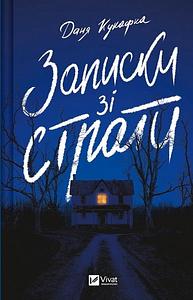You need to sign in or sign up before continuing.
Take a photo of a barcode or cover
challenging
dark
emotional
medium-paced
Plot or Character Driven:
Character
Strong character development:
Yes
Loveable characters:
Complicated
Diverse cast of characters:
No
Flaws of characters a main focus:
Yes
dark
emotional
sad
tense
medium-paced
Plot or Character Driven:
Character
Strong character development:
Yes
Loveable characters:
Complicated
Diverse cast of characters:
Yes
Flaws of characters a main focus:
Yes
Told from the perspective of three females and himself, this story follows Ansel Packer, convicted serial killer, who is scheduled to die in 12 hours.
The book definitely delves into the topic of nature vs nurture. Hearing Ansel's background with his birth family, and subsequent experiences in the foster system was heartbreaking. But on the other hand listening to both Lavender and Saffie's experiences in the same houses and system showed the other side. I enjoyed the female aspect of this book but really didn't love listening to Ansel's point of view. The story was very engaging even though it lost my attention a little bit in the middle with Ansel's perspective of trying to break out (I felt like the story would've been stronger without it).
The last chapter was both chilling and devestating. I loved hearing the perspective of another timeline where the girls lived and what their lives would've been like. As consumers of the gruesome true-crime media, the book is right that we only solely think of and analyze the killer. These women are now only known of an additional sidenote on the perpetrator's life, not for their own selves. Such a thought-provoking ending. Definitely bumped it up a star for me!
The book definitely delves into the topic of nature vs nurture. Hearing Ansel's background with his birth family, and subsequent experiences in the foster system was heartbreaking. But on the other hand listening to both Lavender and Saffie's experiences in the same houses and system showed the other side. I enjoyed the female aspect of this book but really didn't love listening to Ansel's point of view. The story was very engaging even though it lost my attention a little bit in the middle with Ansel's perspective of trying to break out (I felt like the story would've been stronger without it).
The last chapter was both chilling and devestating. I loved hearing the perspective of another timeline where the girls lived and what their lives would've been like. As consumers of the gruesome true-crime media, the book is right that we only solely think of and analyze the killer. These women are now only known of an additional sidenote on the perpetrator's life, not for their own selves. Such a thought-provoking ending. Definitely bumped it up a star for me!
dark
emotional
mysterious
medium-paced
Riveting from start to finish, this book exceeded my expectations. Right at the start, we know that Ansel Parker is headed for his execution. His guilt is not one that is questioned in detail, but we are not given the full story. Going back in time and through multiple perspectives from the women in his life, we learn about the events that deeply affected Ansel as well as the decisions he made throughout his life.
The author used this story to discuss the multitude of factors that can cause a person to hurt someone else, where blame cannot be placed on a single person or event and right or wrong is not as apparent as it may seem on the surface. The characters are well-developed, each damaged in their own way but also with plenty of redeeming qualities. The story did not lag even though it was more literary in nature.
The author used this story to discuss the multitude of factors that can cause a person to hurt someone else, where blame cannot be placed on a single person or event and right or wrong is not as apparent as it may seem on the surface. The characters are well-developed, each damaged in their own way but also with plenty of redeeming qualities. The story did not lag even though it was more literary in nature.
dark
tense
medium-paced
Plot or Character Driven:
A mix
Strong character development:
Complicated
Loveable characters:
Complicated
Diverse cast of characters:
Yes
Flaws of characters a main focus:
Yes
An introspective story that asks readers to consider a different perspective regarding the attention they pay to violent men and the crimes they commit. Amid the uptick in true crime media and the public’s increasing fascination with why men commit the crimes they do, Kukafka highlights an important truth— that everyone experiences pain and trauma, and that it’s what we choose to do with it that matters, not why.
When someone chooses to turn their own pain into a tool for evil, they make an active choice to hurt others. It doesn’t matter why, or how, it only matters that they did it and that it cannot be undone. In Notes on an Execution, Kukafka tells the story of a violent man and his crimes through his encounters with the women in his life. This compelling portrait of his pain, and the choices he makes because of it reminds readers that instead of focusing on the why and the how, we should focus on the victims, who had full, complicated lives that were cut short all because of one person’s choice. Such a thoughtful and hard-hitting story; I definitely recommend.
When someone chooses to turn their own pain into a tool for evil, they make an active choice to hurt others. It doesn’t matter why, or how, it only matters that they did it and that it cannot be undone. In Notes on an Execution, Kukafka tells the story of a violent man and his crimes through his encounters with the women in his life. This compelling portrait of his pain, and the choices he makes because of it reminds readers that instead of focusing on the why and the how, we should focus on the victims, who had full, complicated lives that were cut short all because of one person’s choice. Such a thoughtful and hard-hitting story; I definitely recommend.
challenging
dark
emotional
tense
fast-paced
Plot or Character Driven:
Character
Strong character development:
Complicated
Loveable characters:
No
Diverse cast of characters:
N/A
Flaws of characters a main focus:
Yes
Stunning read. Very compelling and beautifully written
challenging
dark
emotional
mysterious
sad
tense
medium-paced
Plot or Character Driven:
Character
Strong character development:
Complicated
Loveable characters:
No
Diverse cast of characters:
Complicated
Flaws of characters a main focus:
Yes
challenging
dark
mysterious
reflective
sad
tense
medium-paced
Plot or Character Driven:
Character
Strong character development:
Complicated
Loveable characters:
Complicated
Diverse cast of characters:
No
Flaws of characters a main focus:
Yes
It feels weird to say I "liked" this book. It's a very hard read, content wise- think Bright Young Women but if it was actually good. There were so many good quotes in this book that made me pause and think, I started highlighting them. Overall, I think the author did an excellent job at driving her points home, and the author's note perfectly summarizes why she had to write this book: "I am tired of seeing Ted Bundy's face. This is a book for the women who survive."
"This was not about him. It never had been. It seemed insane, almost laughable, that one person- Ansel, a single man, so deeply average- had created a chasm so colossal." (pg. 248)
It's so so important to have art and media focused on the people affected by one person's horrible actions rather than the offending person. Is this a new sentiment in our culture, more specifically in the true crime sphere? Not particularly, but after decades of serial killer books and documentaries and movies mystifying and glorifying men who were, at most, deeply average, I think we can have a few true crime/thriller books written from a feminist lens.
"There are millions of men out there who want to hurt women- people seem to think that Ansel Packer is extraordinary, because he actually did." (pg. 289)
The writing was very good, not too simple and not overwritten/flowery language either. I was sucked into this book from the first page. The author tackled a lot of big and controversial topics but it wasn't preachy at all- the reader is given the freedom to come to their own conclusions.
I always really appreciate when the point is made that the serial killer/abuser/insert-other-crime-here did the things they did because they chose to. There are so many myths and misconceptions around the idea that "hurt people hurt people." In my experience, that phrase just serves to stigmatize survivors/victims even further. More accurately, as one of the main characters realized, "She had finally solved this epic mystery- touched the place where Ansel's hurt had congealed- only to find his pain looked just like everyone else's. The difference lay in what he chose to do with it." (pg. 260)
"This was not about him. It never had been. It seemed insane, almost laughable, that one person- Ansel, a single man, so deeply average- had created a chasm so colossal." (pg. 248)
It's so so important to have art and media focused on the people affected by one person's horrible actions rather than the offending person. Is this a new sentiment in our culture, more specifically in the true crime sphere? Not particularly, but after decades of serial killer books and documentaries and movies mystifying and glorifying men who were, at most, deeply average, I think we can have a few true crime/thriller books written from a feminist lens.
"There are millions of men out there who want to hurt women- people seem to think that Ansel Packer is extraordinary, because he actually did." (pg. 289)
The writing was very good, not too simple and not overwritten/flowery language either. I was sucked into this book from the first page. The author tackled a lot of big and controversial topics but it wasn't preachy at all- the reader is given the freedom to come to their own conclusions.
I always really appreciate when the point is made that the serial killer/abuser/insert-other-crime-here did the things they did because they chose to. There are so many myths and misconceptions around the idea that "hurt people hurt people." In my experience, that phrase just serves to stigmatize survivors/victims even further. More accurately, as one of the main characters realized, "She had finally solved this epic mystery- touched the place where Ansel's hurt had congealed- only to find his pain looked just like everyone else's. The difference lay in what he chose to do with it." (pg. 260)




